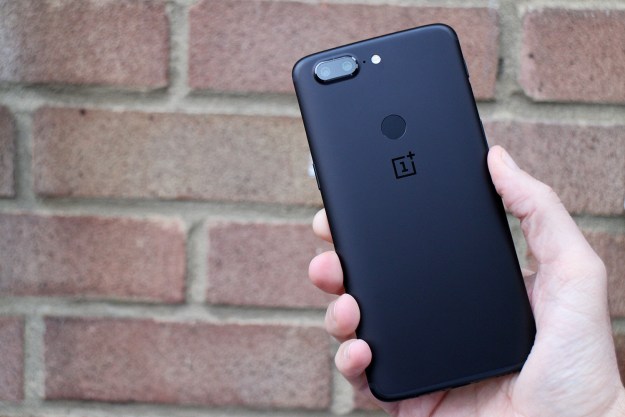
- 6-inch AMOLED screen with slim bezels
- Great performance, simple software
- Competitive price
- Face unlock works well
- Capable camera with strong portrait mode
- No water resistance
- Old version of Android installed at launch
OnePlus is back with the OnePlus 5T, a revised version of its excellent OnePlus 5 smartphone. Much like Apple’s “S” revisions, like the iPhone 6S, OnePlus’ “T” phones largely stick with the same hardware and design as the original, with minor changes that make the phone a more attractive purchase in the latter half of the year. It’s the same approach the company took in 2016 with the OnePlus 3 and 3T, despite saying future T-versions of its smartphones weren’t certain.
The changes with the 5T make a dramatic difference to the way the phone looks. In our OnePlus 5T review, we found a smartphone that’s impossible not to recommend. It offers a brilliant, bezel-less smartphone experience at an amazing price. OnePlus proves again you don’t need to break the bank for a flagship phone.
Slimmed down bezels
The OnePlus 5T is the phone the OnePlus 5 should have been. The most visual change is on the front — the 5T swaps the chunky edges around the screen, and the 16:9 aspect ratio screen for a modern 18:9 screen, with skimpy bezels at the top and bottom.
It transforms the way the OnePlus 5T looks, making it truly a peer alongside other bezel-less smartphones like the Samsung Galaxy S8, the Huawei Mate 10 Pro, and the LG V30. It’s taller and slimmer than the OnePlus 5’s screen, and now measures 6.01-inches rather than 5.5-inches. Despite the larger screen, the phone’s body is almost exactly the same size, though a little heavier at 163 grams. The weight is different enough to notice when you compare the two together, but not in everyday use.
The anodized aluminum body is curved at the sides and smooth to the touch. The back is comfortable and ergonomic, but the sides have a sharp edge to them, which slightly improves grip but isn’t especially pleasing to hold. It’s slippery too, forcing you to hold on tight and further emphasizing the sharp line. We wrapped it in a OnePlus case — the new red silicone one is our favorite — which cured both problems.
The OnePlus 5T is the phone the OnePlus 5 should have been.
Minimizing the edges around the screen also meant getting rid of capacitive buttons and the home button, which doubled as a fingerprint sensor. The sensor has now relocated to the back of the phone, and you can only use on-screen navigation buttons on the 5T. OnePlus has used the outgoing format since the OnePlus 2, and some hardcore fans may find this change controversial. We actually welcome it. Fingerprint sensors on the rear are almost standard across the Android world now, with LG, Samsung, Google, and others all adopting it. It’s natural and convenient, largely because the sensor is well-placed. It also helps that it’s beyond lightning fast.
Changing the design like this has made the OnePlus 5T look less like an iPhone, and we really adore the minimalist approach throughout. Just look at the back: A OnePlus logo, neatly blended in antenna lines, and that’s all.
It’s not all great news though. The camera lens bulge has got bigger, and it’s a shame the fingerprint sensor looks like an afterthought — we would have liked to see it a little more indented or have chamfered edges to make it a little more distinguishable.
None of these tiny issues spoil the OnePlus 5T.
A great AMOLED screen
All this talk about 18:9 aspect ratio screens, and the continued adoption of them by the smartphone industry, may make you wonder if they’re worth the hype. How does the OnePlus 5T’s new screen look? It’s still a gorgeous Full Optic AMOLED panel, just like the one of the OnePlus 5, only with a slightly adjusted Full HD+ resolution, reaching 2,160 x 1,080 pixels spread over the 6.01-inch panel. It’s crisp, has a beautiful color spread with deep blacks, and its high brightness level makes it easy to read in direct sunlight. The OnePlus 5T’s screen really is wonderful.
What’s the difference between looking at a OnePlus 5 (or any other 16:9 aspect ratio screen) and the OnePlus 5T? Let’s take a Twitter feed as an example. On the OnePlus 5T’s screen you see almost an entire tweet more than on the OnePlus 5. The same effect will be seen in most social networking apps, browsing the web, and in other text-based activities in portrait orientation.
In landscape mode, you can pinch out to expand YouTube videos so they take up the whole screen. It crops the image, so videos look cut off sometimes. Does this make it pointless? No. Some Netflix content is made in 18:9 and will fill the screen now, with more to come in the future. Selected games also stretch across the landscape screen, look great, and provide a genuinely more immersive experience.
The OnePlus 5T’s screen really is wonderful to look at.
We hesitate to call the 18:9 aspect ratio screen larger or better than its 16:9 counterpart; but it certainly shows more content in the right situation, which means less scrolling and more reading. We didn’t notice any difference in performance between the AMOLED on the OnePlus 5 and the OnePlus 5T. Viewing angles are excellent, and you can hide the Android navigation keys away from sight to make the most of the edge-to-edge screen.
In addition to a Reading Mode, where color temperature is altered and the screen calibrated based on ambient light to improve reading conditions, OnePlus added Sunlight Display to its adaptive brightness mode. OnePlus said this “changes the contrast of the display to automatically reduce glare in situations where it’s needed,” such as outdoors on a bright day. It kicks in when it’s needed, but is it effective? We have no complaints regarding the screen’s visibility outdoors, so we assume the silent feature is doing its job effectively.
A no frills, reliable camera
OnePlus has retained the dual-lens, 16-megapixel and 20-megapixel cameras from the OnePlus 5 on the T model, but has made some changes to the lenses. Gone is the telephoto lens and in comes a standard lens with an f/1.7 aperture. The intention is to improve low-light performance. Without a telephoto lens, there’s no optical zoom — though you can still quickly jump to 2x digital zoom — and Portrait Mode photos aren’t as close up.
How does Portrait Mode work without the telephoto lens? OnePlus told Digital Trends “the sensors work like your eyes: One is optimized to bring the subject matter to the forefront and one is able to achieve the background blur. You do not need a telephoto lens to achieve bokeh-effect images.”
So how do they look? Results vary, just like all artificial bokeh modes on smartphones. What the OnePlus 5T does well is pick out edges, whether it’s an object or someone’s face, and the shots aren’t cropped down to achieve the portrait effect.
It reminded us more of the Galaxy Note 8’s camera than the iPhone or the OnePlus 5. The low-light performance of the OnePlus 5T’s camera when using Portrait Mode is better than the 5, with less grain and more detail. Taking shots at night outside didn’t reveal the OnePlus 5T to be overly adept at handling poor lighting, despite both lenses having an f/1.7 aperture, and it certainly can’t match the Huawei Mate 10 Pro for stunning nighttime shots. The camera is relatively feature-sparse and has a Pro mode, a panorama mode, plus a time-lapse and slow motion video mode.
The camera app is dead simple to use: Swipe left or right on the viewfinder screen to access video or Portrait Mode. A recent OxygenOS update has changed the user interface slightly, adding text below the viewfinder to show which mode you’re using, plus it has refined the options menu that’s now accessed with a swipe up on the screen. It hasn’t changed the way some of the less often-used features, like the grid, are altered. They’re still hidden under a settings mode at the top right of the menu screen.
One new feature we did like works with the rear fingerprint sensor — you can long press the sensor to take a photo. This works with both rear and selfie cameras, and it’s handy. The 16-megapixel selfie cam doesn’t have a portrait mode, but takes good pictures. Its only feature is a simple beauty mode. A software update says it includes “improvements for photo quality,” but we have yet to notice any major differences.
The OnePlus 5T’s camera is very good, but it’s not spectacular. It’s missing some of the excitement we feel when using the Huawei Mate 10 Pro, the LG V30, or the Google Pixel 2. Regardless, we’re confident the OnePlus 5T will do everything we ask without fuss, and we’ll be happy with the end results.
Unlock with your face
Knowing it may face some backlash to for moving the fingerprint sensor to the rear, OnePlus has added another way to unlock the phone on the front. Face Unlock works with the selfie camera to identify and unlock your face, and it works exceptionally well. Glance at a locked screen and the phone quickly springs to life. It’s incredibly fast, and in our experience beats the iPhone X and the Galaxy Note 8 for speed. It matches LG’s similar system.
Face Unlock works with the selfie camera, and it works exceptionally well.
How has OnePlus managed such a feat? It’s not used for security, so the requirements aren’t as stringent as they are on the iPhone or the Note 8. OnePlus said it’s for convenience, and to emphasize this, you can’t use Face Unlock with Android Pay or with any secure app.
It works superbly, and it is indeed convenient. If you’re worried about it not being secure, you can turn it off, and stick with the fingerprint sensor. In its Oxygen OS 4.7.4 update, OnePlus optimized the system even more, but as it worked consistently for us before, it hasn’t changed the experience.
Customizable software, strong performance
OnePlus has left the internal specifications alone for the 5T, keeping the Snapdragon 835 processor and offering a choice of 6GB of RAM with 64GB of storage space, and 8GB of RAM with 128GB of storage space. Don’t be fooled into thinking 8GB of RAM makes the OnePlus 5T perform differently to the 6GB model. We tried both OnePlus 5 models and couldn’t tell the difference, and we expect it’s the same with the OnePlus 5T. It’s worth paying extra for the 128GB of storage space if you download a lot of media, as the 5T doesn’t offer a MicroSD card slot.
Running some benchmarks, we got the following results:
- GeekBench 4: Single-core 1,934; Multi-core 6,678
- AnTuTu 3D: 180,588
- 3DMark Sling Shot Extreme: 3,199
The OnePlus 5’s AnTuTu score (181,599) was marginally higher than the OnePlus 5T, which makes sense because the same processor is powering a slightly larger, and higher-resolution screen. But the OnePlus 5T still beats out some of the other competition — the Samsung Galaxy S8, for example, scored 155,253 on AnTuTu, and 2,052 on 3DMark.
The software experience is the same as the OnePlus 5. Android 7.1.1 is installed, disguised as OnePlus’s OxygenOS, and it’s relatively close to standard Android with a few simple changes. What’s frustrating is it’s not Android 8.0 Oreo underneath. Yes, OnePlus said it’s coming in the first quarter of 2018, but for a company that told us its software department was working harder to bring out more timely updates, we’re disappointed not to see the latest version on a brand-new phone.
This means you miss out on Notification Dots on app icons, picture-in-picture mode, and a few other great new features in Android 8.0 Oreo, along with the latest security and performance enhancements. None of this means OxygenOS is slow or annoying. It’s hands down one of the better Android user interfaces out there, due to its similarity to untouched Android. We like the pull-up app drawer, the notification shade’s simplicity, and the various gestures including a double tap to wake screen. There are so many things you can customize to your liking, allowing you to make your phone look exactly how you want.
Turn on the ambient display and messages pop up on the black sleep screen in a subtle, and really stylish way. It’s eye-catching when the phone is on a desk, but the notifications don’t stay around for too long, avoiding prying eyes.
Day-long battery life, and a headphone jack
It’s a 3,300mAh battery inside the OnePlus 5T, and it’s charged using the proprietary Dash Charge system, which zips it to 60 percent in 30 minutes, and to a full charge in less than 90 minutes. It’s consistently reliable, and a genuinely helpful feature. The 60 percent is supposed to last a full day — hence the company’s “A day’s worth of power in half an hour” tagline — and in our experience this is accurate. If you don’t have the chance to give the battery a boost, a full charge has typically lasted us a day and a half. Turn the phone off overnight, and this will mean two working days should be achievable.
Rejoice, for the OnePlus 5T still has a headphone jack, despite the thinner screen bezels. It’s still a great experience for those using a wireless set up, thanks to Bluetooth 5 and support for AptX HD. While the AptX HD performance can’t quite match LG’s phones, wired headphones sound excellent, especially when using the built-in presets and tuning. OnePlus hides this away in the general settings, because it doesn’t have its own music app.
Price, warranty, and availability
How much extra is OnePlus charging for the OnePlus 5T, over the now discontinued OnePlus 5? The very good news is it isn’t much at all. In the U.S. the phone is $500 for the 64GB model, and $560 for the 128GB. It’s sold through the OnePlus website. The 64GB version is 450 British pounds in the U.K., and the 128GB is 500 British pounds. OnePlus also continues its relationship with the O2 network, where it will be sold with a various contract options.
There are at least two special edition OnePlus 5T phones available too. In China, you can buy a lava red version of the phone, while in India, there’s a Star Wars branded OnePlus 5T available. It has a Star Wars logo on the back, and a selection of custom wallpapers and themes installed. Currently, neither of these are sold outside their respective countries.
OnePlus has a one-year warranty on its devices in the U.S., and two-years in the U.K. Phones with any manufacturing defects will be repaired or replaced free of charge, with shipping and handling costs included. Unless you mistreat the device, or it gets damaged through daily wear and tear, when it won’t be covered. Alternatively, OnePlus offers an extended warranty plan though Assurant Solutions called On-Guard. You can pay for a year, 18 months, or two years. The advantage is claims are dealt with in the U.S, so things should move quicker. Prices range between $20 and $110 extra.
Our Take
OnePlus continues to make it difficult to justify spending more on a smartphone. So don’t. The OnePlus 5T is really all you need.
Are there any better alternatives?
We’ve talked about the specs already, so it’s clear the OnePlus 5T can take on the best smartphones like the Galaxy S8, LG V30, and the iPhone 8 in terms of power and ability. Its feature list isn’t as extensive, but we don’t really consider this to be a negative aspect. OnePlus wants to play with the big boys, except it’s not charging big-boy prices.
That makes direct alternatives scarce. The 380 British pound Honor 9, which is only available in the U.K., comes close with its stunning design and its strong processor and camera, as does the larger 480 British pound Honor 8 Pro. Honor has also released the Honor 7X, which while not as technically impressive as the OnePlus 5T, is considerably less expensive — just $200 in the United States — and is a phone worth considering if you’re already stretching your budget. Additionally, the Honor View 10 will directly compete with the OnePlus 5T when it’s released in January 2018.
Otherwise, you’ll have to dig a little deeper to get a comparable phone. We’d recommend the Google Pixel 2, or Google Pixel 2 XL. The camera is better, you get regular software updates, a water-resistant phone, and a similar joy of using stock Android. The Pixel 2 XL’s the only one of the two that can take on the OnePlus 5’s style though, and it’s $750. Beginning to see just what great value the OnePlus 5T really is? There’s also the Essential Phone, which costs the same $500, but it’s major downside is the camera isn’t as good.
How long will it last?
One advantage most other flagship smartphones have over the OnePlus is water-resistance — you’ll find none on the 5T. If you get the OnePlus 5T wet, you run the risk of it not working again. It’s not a tough body either, although because it’s metal it won’t be fragile in the same way as an iPhone 8 or Galaxy S8.
Software updates are also another concern. Android 8.0 Oreo is coming, but what comes after that is another matter. OnePlus’s track record here isn’t the best. The only way to guarantee timely software updates is to buy a Google Pixel 2 or Pixel 2 XL.
All this said, the phone is internally up to date, and the phone’s style will keep it looking fresh for a good few years. You’ll get two years strong use out of the OnePlus 5T before you even need to consider changing it for a more modern device — and the OnePlus 6 will be out long before then.
Should you buy it?
Yes. In a year where at least one smartphone has topped $1,000, the $500 OnePlus 5T is astonishingly good value given the hardware specification and style. OnePlus has ignored the temptation to add in many extra features, keeping the phone simple, accessible, and laser-focused. Buy one, and you’ll smugly chuckle at others who feel the need to spend more on a smartphone this year.
Update: We’ve added in changes to the camera app from new OxygenOS update, comparisons to the Honor 7X and Honor View 10, and news of special edition designs.
Editors' Recommendations
- OnePlus surprises us with dazzling Android tablet and smartwatch
- OnePlus just fixed a big issue with the OnePlus Watch 2
- Is the OnePlus Watch 2 waterproof?
- The best OnePlus 12R cases in 2024: the 9 best ones we found
- Have T-Mobile? Your 5G service is about to get much faster




















